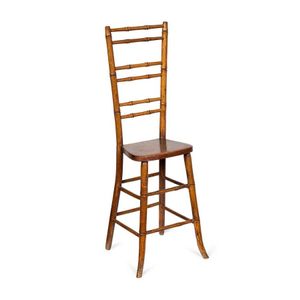Arts & Crafts Mahogany Elbow Chair with Rush Seat
You must be a subscriber, and be logged in to view price and dealer details.
Subscribe Now to view actual auction price for this item
When you subscribe, you have the option of setting the currency in which to display prices to $Au, $US, $NZ or Stg.
- Mahogany - Mahogany is a dense, close grained red-coloured timber from the West Indies and Central America. It was first imported into Europe in the the early 18th century and its use continued through the 19th century. It was popular for furniture making because of its strength, the wide boards available, the distinctive grain on some boards, termed flame mahogany and the rich warm colour of the timber when it was polished.. The "flame" was produced where a limb grew out from the trunk of the tree, and this timber was usually sliced into veneers for feature panels on doors, backs and cornices.
Some terms used to describe mahogany relate to the country from which it originally came, such as "Cuban" mahogany, "Honduras" mahogany etc. However unless the wood has been tested the names assigned are more a selling feature, rather than a true indication of the timber's origin. - Rush Seating - Associated with country style chairs, stools and settees, rush seats are woven from rushes, with the pattern of the weaving often dividing the the chair seat diagonally into four triangles.
The weaving of rushes has been practiced for centuries, and it is believed that some early rush seats of the 18th and 19th century were painted, although common practice now is to leave the rush in its natural state. As the rush ages the colour
Rushes of the type used in Europe for seating are not available in Australia, and instead fibre rush, a man-made product from one-ply twisted paper, is used. Another substitute material is twisted natural sea grass.
Seats in Danish furniture of the 1950s were often finished with Danish cord, a three ply twisted paper cord, which has a similar appearance to rush. - Elbow Chair - Another name given to a dining chair with arms, more commonly called a carver chair.
- Turning - Any part of a piece of furniture that has been turned and shaped with chisels on a lathe. Turned sections include legs, columns, feet, finials, pedestals, stretchers, spindles etc. There have been many varieties and fashions over the centuries: baluster, melon, barley-sugar, bobbin, cotton-reel, rope-twist, and so on. Split turning implies a turned section that has been cut in half lengthwise and applied to a cabinet front as a false decorative support.
- Stretcher - A horizontal rail which connects the legs of stools, chairs, tables and stands, to provide stabilisation of the legs. A stretcher table is any table with a stretcher base. The term is usually applied to substantial farmhouse tables, although many cabinetmaker's pieces, such as sofa tables, also have turned stretchers.
This item has been included into following indexes:
-
chairs, singles / pairs / threes, style or period
- Arts & Crafts 61
- elbow 198
- rush-seated 115
- chairs, singles / pairs / threes, timber - mahogany 1,129
Visually similar items

A French provincial oak ladder back child's chair, 19th century

Hans Wegner, side chair, with teak frame and woven cane seat, made in the traditional Arts & Crafts style, impressed monogram and manufactures number 0603

Rustic stained pine side chair, with enclosed spindle back and plank seat, height 56 cm. Provenance: The Estate of Ray Hughes

An oak and ash rush seated country chair, English, 19th century
